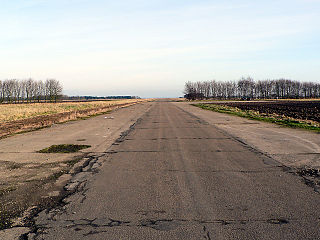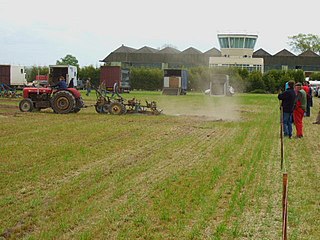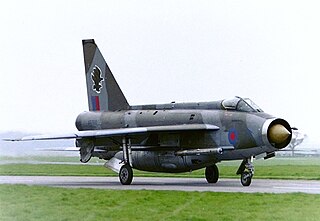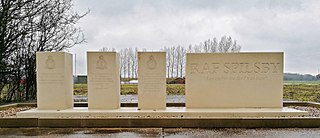
Royal Air Force Coningsby or RAF Coningsby, is a Royal Air Force (RAF) station located 13.7 kilometres (8.5 mi) south-west of Horncastle, and 15.8 kilometres (9.8 mi) north-west of Boston, in the East Lindsey district of Lincolnshire, England. It is a Main Operating Base of the RAF and home to three front-line Eurofighter Typhoon FGR4 units, No. 3 Squadron, No. 11 Squadron and No. 12 Squadron. In support of front-line units, No. 29 Squadron is the Typhoon Operational Conversion Unit and No. 41 Squadron is the Typhoon Test and Evaluation Squadron. Coningsby is also the home of the Battle of Britain Memorial Flight (BBMF) which operates a variety of historic RAF aircraft.
Royal Air Force Fiskerton or more simply RAF Fiskerton was a Royal Air Force station located north of the Lincolnshire village of Fiskerton, 5.0 miles (8.0 km) east of Lincoln, Lincolnshire, England. The airfield closed at the end of the war in 1945 being a satellite to RAF Scampton and very little now exists. The station was home to some 2000 personnel during the war, and various technical sites were in what is now the village of Fiskerton. A small cluster of semi-derelict buildings still exist and are still in use at the end of the present village on the road out to short ferry. Drake's view is the entrance to these old buildings.

Royal Air Force East Kirkby or more simply RAF East Kirkby is a former Royal Air Force station near the village of East Kirkby, south of Horncastle in Lincolnshire, just off the A155. The airfield is now home to the Lincolnshire Aviation Heritage Centre air museum.

Royal Air Force Grimsby or more simply RAF Grimsby is a former Royal Air Force station located near Grimsby, Lincolnshire, England. The site was operational during the Second World War as part of RAF Bomber Command initially as a satellite station for the Vickers Wellington bombers of RAF Binbrook. By early 1943 the station was equipped with Avro Lancaster bombers of No. 100 Squadron RAF.

Royal Air Force Goxhill or RAF Goxhill is a former Royal Air Force station located east of Goxhill, on the south bank of the Humber Estuary, opposite the city of Kingston upon Hull, in north Lincolnshire, England.

Royal Air Force Metheringham or more simply RAF Metheringham is a former Royal Air Force station situated between the villages of Metheringham and Martin and 12.1 mi (19.5 km) south east of the county town Lincoln, Lincolnshire, England.

Royal Air Force Fulbeck or more simply RAF Fulbeck is a former Royal Air Force station located 6.3 miles (10.1 km) east of Newark-on-Trent, Nottinghamshire and 10.9 miles (17.5 km) west of Sleaford, Lincolnshire, England.
Bruce Barrymore Halpenny was an English military historian and author, specializing in airfields and aircraft, as well as ghost stories and mysteries. He was also a broadcaster and games inventor.

Royal Air Force Lindholme or more simply RAF Lindholme is a former Royal Air Force station in South Yorkshire, England. It was located 3.9 miles (6.3 km) south of Thorne and 6.9 miles (11.1 km) north east of Doncaster and was initially called RAF Hatfield Woodhouse.
Royal Air Force Sandtoft or more simply RAF Sandtoft is a former Royal Air Force station in North Lincolnshire between Doncaster, South Yorkshire and Scunthorpe, North Lincolnshire, England.

Royal Air Force North Killingholme or more simply RAF North Killingholme is a former Royal Air Force station located immediately west of the village of North Killingholme in North Lincolnshire, England.

Royal Air Force Bardney or RAF Bardney is a former Royal Air Force station located 1.7 miles (2.7 km) north of Bardney, Lincolnshire, England and 10.2 miles (16.4 km) east of the County town of Lincoln. It was built as a satellite to RAF Waddington in 1943 and the airfield closed in 1963.

Royal Air Force Binbrook or RAF Binbrook is a former Royal Air Force station located near Binbrook, Lincolnshire, England. The old domestic site has been renamed to become the village of Brookenby. RAF Binbrook was primarily used by Bomber Command in the Second World War. The Central Fighter Establishment moved to Binbrook from RAF West Raynham between 1959 and 1962 and two English Electric Lightning squadrons were stationed there between 1965 and 1988.
Royal Air Force Wickenby, or more simply RAF Wickenby, was a purpose-built Royal Air Force satellite station constructed late 1942 and early 1943. It lies halfway between Wickenby and Holton cum Beckering, to the south-east of Wickenby close to the B1399 in West Lindsey, 8 NM north-east of Lincoln, England.

Royal Air Force Spilsby or more simply RAF Spilsby is a former Royal Air Force station during the Second World War and the Cold War located in the rural village of Great Steeping, near the market town of Spilsby, Lincolnshire, England.
Royal Air Force Skellingthorpe or more simply RAF Skellingthorpe is a former Royal Air Force station which was operational during the Second World War. It was located just west of the city of Lincoln, England about 2.5 miles (4 km) south-east of the village of Skellingthorpe on a field previously called Black Moor. After its closure the site was developed as the Birchwood estate.
Royal Air Force Doncaster or more simply RAF Doncaster, also referred to as Doncaster Aerodrome, is a former Royal Air Force station near Doncaster, South Yorkshire, England.

Royal Air Force Ludford Magna or more simply RAF Ludford Magna is a former Royal Air Force station located on agricultural farmland immediately south of the village of Ludford, Lincolnshire and was sited 21. 4miles (34.4 km) north east of the county town of Lincoln, Lincolnshire, England.

Royal Air Force Cammeringham or more simply RAF Cammeringham was a Royal Air Force station used by RAF Bomber Command between 1940 and 1945 and the Polish Air Force until 1946. The airfield was located between the A15 and B1398 roads, 10.3 mi (16.6 km) north of the city Lincoln, Lincolnshire, England and due east of the village of Ingham.

Beverley Aerodrome, was a First World War era Royal Flying Corps training depot, in Bishop Burton, East Riding of Yorkshire, England. The site, like many others in Yorkshire, was developed from a racecourse on the western edge of Beverley, along the road between Beverley and York. Initially set up as a location for squadrons employed in Home Defence (HD), particularly preventing Zeppelin attacks on Hull and the east coast, the site later became a training depot for squadrons and flights who would then deploy to the front line. Beverley was also used as a standing up and transfer location for six Canadian Reserve Squadrons in 1917, all of which were posted to Canada. Beverley Aerodrome was used between 1916 and 1920, with the RAF later using the site in the 1930s in a non-flying role.




















